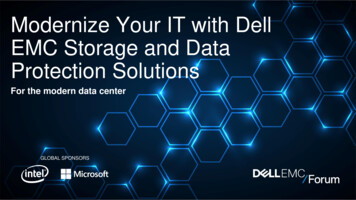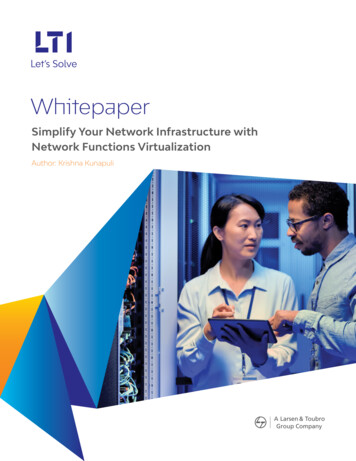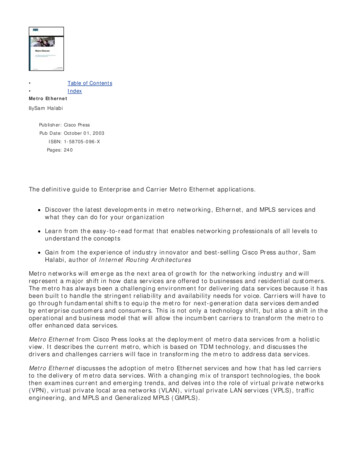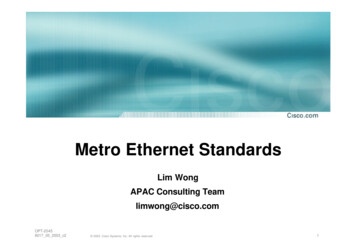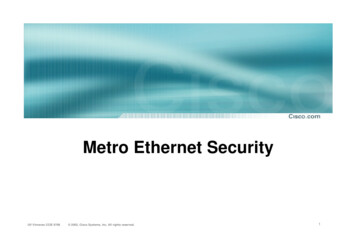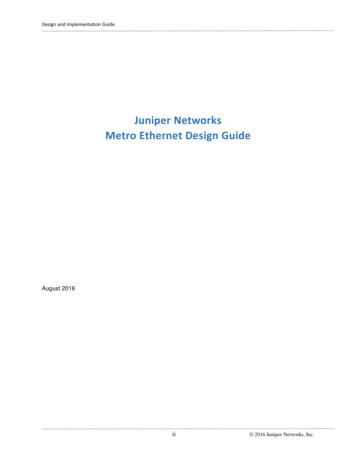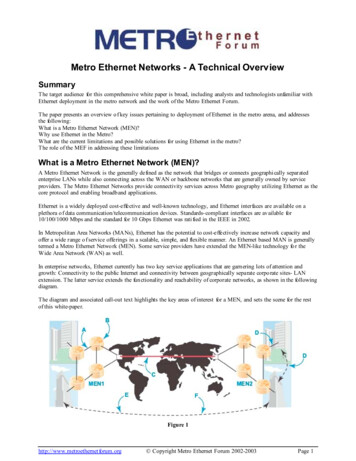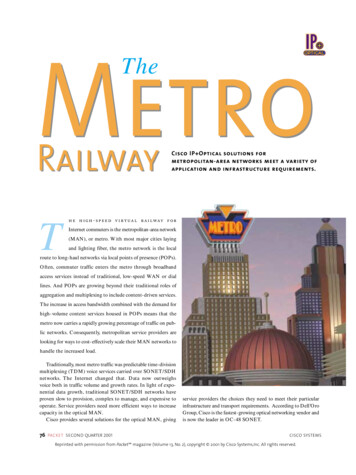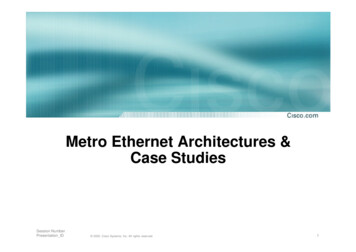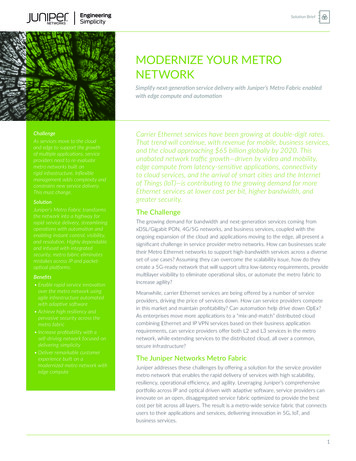
Transcription
Solution BriefMODERNIZE YOUR METRONETWORKSimplify next-generation service delivery with Juniper’s Metro Fabric enabledwith edge compute and automationChallengeAs services move to the cloudand edge to support the growthof multiple applications, serviceproviders need to re-evaluatemetro networks built onrigid infrastructure. Inflexiblemanagement adds complexity andconstrains new service delivery.This must change.SolutionJuniper’s Metro Fabric transformsthe network into a highway forrapid service delivery, streamliningoperations with automation andenabling instant control, visibility,and resolution. Highly dependableand infused with integratedsecurity, metro fabric eliminatesmistakes across IP and packetoptical platforms.Benefits Enable rapid service innovationover the metro network usingagile infrastructure automatedwith adaptive software Achieve high resiliency andpervasive security across themetro fabric Increase profitability with aself-driving network focused ondelivering simplicity Deliver remarkable customerexperience built on amodernized metro network withedge computeCarrier Ethernet services have been growing at double-digit rates.That trend will continue, with revenue for mobile, business services,and the cloud approaching 65 billion globally by 2020. Thisunabated network traffic growth—driven by video and mobility,edge compute from latency-sensitive applications, connectivityto cloud services, and the arrival of smart cities and the Internetof Things (IoT)—is contributing to the growing demand for moreEthernet services at lower cost per bit, higher bandwidth, andgreater security.The ChallengeThe growing demand for bandwidth and next-generation services coming fromxDSL/Gigabit PON, 4G/5G networks, and business services, coupled with theongoing expansion of the cloud and applications moving to the edge, all present asignificant challenge in service provider metro networks. How can businesses scaletheir Metro Ethernet networks to support high-bandwidth services across a diverseset of use cases? Assuming they can overcome the scalability issue, how do theycreate a 5G-ready network that will support ultra low-latency requirements, providemultilayer visibility to eliminate operational silos, or automate the metro fabric toincrease agility?Meanwhile, carrier Ethernet services are being offered by a number of serviceproviders, driving the price of services down. How can service providers competein this market and maintain profitability? Can automation help drive down OpEx?As enterprises move more applications to a “mix-and-match” distributed cloudcombining Ethernet and IP VPN services based on their business applicationrequirements, can service providers offer both L2 and L3 services in the metronetwork, while extending services to the distributed cloud, all over a common,secure infrastructure?The Juniper Networks Metro FabricJuniper addresses these challenges by offering a solution for the service providermetro network that enables the rapid delivery of services with high scalability,resiliency, operational efficiency, and agility. Leveraging Juniper’s comprehensiveportfolio across IP and optical driven with adaptive software, service providers caninnovate on an open, disaggregated service fabric optimized to provide the bestcost per bit across all layers. The result is a metro-wide service fabric that connectsusers to their applications and services, delivering innovation in 5G, IoT, andbusiness services.1
Modernize Your Metro NetworkFeatures and Benefitsupgrading operating systems. A plug-in package that providesthe drivers and support files needed to bring hardware online,Junos Continuity eliminates OS upgrades and system rebootswhen adding new hardware. Unified ISSU reduces the risksassociated with OS changes by enabling upgrades between twodifferent Juniper Networks Junos operating system releases(major or minor) with no control plane disruption and minimaltraffic disruption on the forwarding plane.ScalabilityWith L2 or L3/MPLS architectures, decoupling physicaltopology for transport and service layers allows serviceproviders to scale their networks to tens of thousands or evenhundreds of thousands of nodes. Scalable platforms for 100GbEin the access, aggregation, and Data Center Interconnect (DCI)are fully optimized to reach new thresholds in Ethernet VPN(EVPN), segment routing, and MPLS. Segment routing is asignificant improvement that reduces overhead in control planesignaling while improving path computations and retaining keyfeatures like MPLS fast reroute (FRR).Simplified OperationsTo address the challenge of provisioning and performing dailyoperational tasks, Junos OS includes embedded scriptingtools and APIs that automate routine and repetitive tasks,allowing easy integration with virtually any operator’s backendmanagement tools. This helps you gain greater traffic visibilitythrough customer microservices built on standards-based YANGmodels. Junos Telemetry Interface (JTI) provides greater visibilityfor gathering, aggregating, and streaming real-time network dataand events throughout the metro network. JTI helps identify,isolate, and resolve issues with minimal human interaction,while a Zero Touch Provisioning (ZTP) feature dramaticallyreduces the complexity of extending MPLS in the access layer.This accelerates new box deployments, improving operationalefficiency and lowering OpEx. Programmable interfacessuch as terminal interface processor (TIP), OpenConfig, andOpenROADM Multi-Source Agreement (MSA) increase theprogrammability of the transport layer.ResiliencyEnabling MPLS significantly decreases the risk of L2 loops.Based on Layer 2 VPN (L2VPN) and virtual private LAN service(VPLS), including its variations—either LDP or BGP signalingbased—MPLS represents a critical step in preventing broadcaststorms (compared to native Ethernet switch environments).In addition, Juniper’s Metro Fabric provides multihomedconnectivity between customer premises equipment (CPE) andaccess nodes, as well as between access nodes and aggregationnodes, creating a true loop-free, resilient network.Juniper Networks Junos Continuity and unified in-servicesoftware upgrade (unified ISSU) features eliminate thedowntime risks associated with implementing new hardware orJunos Space Platform (CSD/CPP) / proNX Optical Director / NorthstarMetro AccessCell Site/Customer PremisesMetro AggregationMTSO/COMetro Core and EdgeEnd OfficeMetro/Regional OfficeIPsecE1/STM1-4-CEGPSAntennaIPsecPTX SeriesIPsecRNC/4G 2100/ACX2200MX960MX10003MX204IPsecMX801/10 GbEDSLAM/POM10GbEeNodeBACX4000MX480ACX5048BizCloud Services10GbE High DensityAccess RouterACX509610GbE High DensityAgg RouterInternetIPsecE1/STM1-4-CEPTX SeriesMX9601588v2 and SyncEACX500BTI7800 / ACX6360BTI7800 / ACX6360TCX1000Figure 1: Juniper Networks Metro Fabric product portfolio2
Modernize Your Metro NetworkTable 1: Industry Definitions of Metro ss/E-TransitIETFVirtual private wire service(VPWS)Virtual private LAN service (VPLS)Achieved with VPLS and specificflooding rulesAchieved with VPLS, VPWS, andVLAN translationJunos OS CLIL2 circuit (targeted LDP signalingpseudowires)L2VPN (BGP)H-VPLSVPLSEVPNH-VPLSVPLSEVPNL2 CircuitVPLSFlexible-vlan-taggingService FlexibilityJuniper’s Metro Fabric allows users to deliver fully compliantMetro Ethernet Forum (MEF CE 2.0) services such as E-Line,E-LAN, E-Tree, and E-Access/E-Transit. Table 1 shows howJunos OS-specific terms and features map to MEF and IETFstandards. What’s more, Juniper’s Metro Fabric, designed withan open framework, delivers the flexibility to provide not onlyL2 but also L3 services of all kinds, allowing operators to evolvethe metro architecture on their own terms.SecuritySecurity is integrated and pervasive in Juniper’s Metro Fabric.Security is critical in use cases like mobile backhaul, whereIPsec-based secure gateways provide robust traffic encryption.For DCI, Juniper’s Open Cloud Interconnect offers EVPN andVirtual Extensible LAN (VXLAN) with Media Access ControlSecurity (MACsec) for highly scalable, low power, coherentdense wavelength-division multiplexing (DWDM). As more andmore services get distributed to the network edge, securitywill become increasingly vital. Unified security policies acrossphysical and virtual infrastructure will deliver end-to-endvisibility, real-time threat intelligence and mitigation, andadvanced threat protection of any workload.Solution ComponentsJuniper’s Metro Fabric consists of the following components.ACX Series Routers in the Access LayerIn the access layer, Juniper Networks ACX500 and ACX4000Universal Metro Routers serve as MEF CE 2.0-compliant, costoptimized access nodes loaded with the full features of MPLSrouters and Metro Ethernet switches. With ACX Series routers,users can configure IPv4, bridging, or L2 circuit cross-connect(CCC) traffic families on the same physical port. Leveraging amobile backhaul cell site router feature set, ACX Series routersact as a true universal access node, interconnecting customersites that are still using legacy services. ACX Series platforms letyou migrate those services and backhaul them over Ethernet.ACX Series Routers in the Metro Aggregation SegmentJuniper Networks ACX5000 Universal Metro Routersincorporate the full ACX Series feature set while openingnew horizons for metro area network (MAN) operators. TheACX5000 line of routers provides high-bandwidth businessservices or mobile backhaul metro services with strict servicelevel agreements (SLAs) and minimum provisioning efforts at ahighly attractive price per port and with a flexible license-basedfeature set. The ACX5000 line is perfect for ongoing accessnetwork transformations, as well as for migrating from 1GbE to10GbE in the access and aggregation layers.Packet Optical Transport Platform in the Metro Access andAggregation SegmentJuniper Networks BTI7800 line of Packet Optical TransportPlatforms supports large-scale 10 Gbps, 100 Gbps, and 200Gbps wavelength capacities in a programmable platform.Featuring a rich set of optical capabilities, including coherentmodules with integrated reconfigurable optical add/dropmultiplexers (ROADMs), the BTI7800 line helps serviceproviders increase network capacity, reduce space, power, andcooling costs, improve network utilization, and simplify thedeployment of next-generation services.The Juniper Networks ACX6360 Universal Metro Routerprovides a bridge between the secure packet optical transportlayer and the IP/MPLS networking layer by giving operatorsthe ability to seamlessly collapse both layers into a singleplatform. The ACX6360 converges a full IP/MPLS stack withsecure packet optical transport in a space- and power-optimizedplatform designed for breakthrough capacity and deploymentsin DCI, metro, and Remote-Phy locations—both today and inthe future. The ACX6360 implements secure transport basedon IEEE 802.1AE/802.1X industry-compliant 256AES MACsecencryption while supporting modern automation and telemetrytools via Junos OS to meet cloud-grade routing principles.MX Series Routers in the Metro Aggregation and CoreSegmentsJuniper Networks MX Series 5G Universal Routing Platforms areused in the aggregation and core segments, giving carriers bestin-class performance and functional flexibility. Leveraging a Layer2 service head-end termination function, MX Series routers cancollapse the MAN edge function with service edge functionsin the same routing node. A metro network based on Juniperplatforms performs equally well, providing connectivity servicesof any kind—L2 or L3—with service touchpoints placed anywherein the MAN or network cloud.3
Modernize Your Metro NetworkPTX Series Routers in the Core SegmentNorthStar ControllerIn geographically separated MANs, early adopters of 100GbEmay opt to leverage Juniper Networks PTX Series PacketTransport Routers, which provide a core function enhancedby router-integrated 100GbE optical transponders. Thesetransponders provide the ability to establish long-haul, back-toback connectivity that can span hundreds of kilometers withoutsignal amplification.Juniper Networks NorthStar Controller is a flexible trafficengineering solution that delivers granular visibility into andcontrol over IP/MPLS and optical layer flows. It streamlinescapacity planning, enables proactive monitoring, and lets serviceproviders dynamically route traffic and balance loads based onadministratively defined policies.Programmable Photonic LayerThe Juniper Networks TCX1000 Programmable ROADM is anintegral part of Juniper’s Programmable Photonic Layer openline system. Forming a colorless, directionless, flex grid-readyROADM, it scales up to 25.6 Tbps per line for long-term growthinvestment across all metro use cases.Junos Space PlatformJuniper Networks Junos Space Network ManagementPlatform provides comprehensive management with broadfault, configuration, accounting, performance, and securitymanagement (FCAPS) capabilities for both device- andservice-level management. For device management, the JunosSpace platform supports Network Configuration Protocol(NETCONF), CLI, and SNMP v1/v2/v3. Its northbound APIssupport easy integration with existing network managementsystems and operations/business support systems (OSS/BSS).Running on the Junos Space Management Platform, JunosSpace Connectivity Services Director (CSD) ensures effortless,end-to-end service provisioning of carrier Ethernet (E-Line,E-LAN, E-Tree, E-Access/E-Transit), VPLS, L3VPN, and MPLSusing a simple interface to design, validate, and manage theseservices. Another Junos Space application, Cross ProvisioningPlatform (CPP), helps service providers provision E-Line, L2/L3 VPN services, and VPLS between Juniper and third-partydevices, while the Connectivity Services Director tool providesthe operational team with full life-cycle management overconnectivity services.proNX Optical DirectorThe Juniper Networks proNX Optical Director softwareplatform enables full management of and control over JuniperProgrammable Photonic Layer open-line system elements, aswell as Juniper’s coherent DWDM transponder-based solutionssuch as the Juniper Networks BTI Series Packet OpticalPlatforms and integrated DWDM transponders on MX Seriesand PTX Series routers. The proNX Optical Director enablesyou to more easily and reliably deploy, scale, and integrateapplications and services.Use CasesJuniper’s Metro Fabric delivers significant, real-world benefits inthe following use cases.L2 Business AccessFor service providers providing Layer 2 business access servicesto corporate clients and other service providers, VPLS offers aunified method for providing end-to-end service connectivityor connecting access segments running different protocols.Juniper has implemented multiple features into its metro fabricthat make this type of “stitching” extremely reliable, ensuringinteroperability between different flavors of Spanning TreeProtocol (STP) or Ethernet Ring Protection (G.8032v1/v2).L3 Business Access and Direct Internet AccessThe ACX500, ACX1000 line, and ACX2000 line of UniversalMetro Routers can be deployed as network interface devices(NIDs) to provide L2/L3 business access, Direct Internet Access(DIA) connectivity, and IP services such as IP VPN. Juniper’sMetro Fabric features robust Operation, Administration,and Maintenance (OAM), as well as SLA control capabilities.Combined with automation and ZTP, the solution supportsseamless migration from 1GbE to 10GbE, supported by 100GbEmetro aggregation.Mobile Backhaul and FronthaulIn addition to MEF CE 2.0 compliance supporting both Ethernetand IP/MPLS, Juniper’s Metro Fabric provides high capacityand scalability, complete timing and synchronization, integratedsecurity, and SLA tools that differentiate mobile backhaul andfronthaul services. Additionally, the ACX500 delivers a lastmile deployment solution for small cell-as-a-service offerings.Exponential bandwidth growth and preparation for 5G is driving10GbE at the access and 100GbE at the pre-aggregation layers.Residential AggregationMetro Ethernet networks aggregate Ethernet links from serviceprovider broadband access nodes—DSL access multiplexers(DSLAMs), Ethernet Access Devices (EADs), cable modemtermination systems (CMTS), etc.—or, in some cases, directlyfrom residential CPE, delivering traffic to the broadbandnetwork gateway (BNG). Juniper’s Metro Fabric supports4
Modernize Your Metro Networkmulticast traffic delivery, which triple-play service providers canuse to backhaul IPTV/OTT services. Specifically, the ACX5000line is perfect for a converged fiber to the home, building,premise, node, or curb, and GPON metro aggregation solutions.Residential traffic growth is forcing metro networks to look atcost-effective models to scale the aggregation to 100GbE.Ethernet Cloud ExchangeEthernet Cloud Exchange is a relatively new network-neutralservice that improves quality and removes the cost andcomplexity of interconnecting the L2 Ethernet networks ofcarriers, operators, and service providers. High capacity, highport density, and low power consumption—in combination witha rich MEF and IP feature set—all make the ACX5000 line aneffective metro aggregation platform for Ethernet Exchangeservice providers. Scalable architectures for spine and leaf in thedata center allow high-capacity direct connections to multipleclouds. To support the dynamic requirements in the EthernetCloud Exchange, YANG/NETCONF enables service providertools to automate across the development life cycle, so newservices can be launched quickly and cost-effectively.Cable Distributed Access ArchitectureConsumer consumption of 4K video, business services, andstreaming content continues to drive bandwidth growth.Distributed Access Architecture (DAA) helps cable networksevolve into virtualized network functions, decentralizing thecontrol and user planes. The head-end will evolve towards morehigh-capacity fiber-based Ethernet links, and this will improvecost efficiencies to support bandwidth growth. Juniper’s MetroFabric will drive a fiber-deep architecture to enable multigigabitbroadband by adopting the Remote MAC-PHY and a transitiontowards digital optics. The benefits of IP convergence includebetter returns on capital expenditures and lower operationalcosts through automation.Corporate and Sales HeadquartersAPAC and EMEA HeadquartersJuniper Networks, Inc.Juniper Networks International B.V.1133 Innovation WayBoeing Avenue 240Sunnyvale, CA 94089 USA1119 PZ Schiphol-RijkPhone: 888.JUNIPER (888.586.4737)Amsterdam, The Netherlandsor 1.408.745.2000Phone: 31.0.207.125.700Fax: 1.408.745.2100Fax: 31.0.207.125.701Summary—Scalable, Resilient, and FlexibleMetro Fabric for Future Business GrowthAs demand for applications, services, and bandwidth continuesto grow, service providers need to effectively scale networknodes to support higher capacities, improve operations throughautomation, and transform customer experiences by offeringnew, differentiated services to win in a very competitivemarketplace. Juniper Networks addresses these challenges byoffering a complete, integrated Metro Fabric that delivers highscalability, resiliency, operational efficiency, service flexibility,and security. This enables service providers to profitably servemultiple customers with differentiated services over a singleinfrastructure, increase profitability with a self-driving networkfocused on delivering simplicity, and deliver exceptionalcustomer experiences built on a modernized metro networkwith edge compute.Next StepsTo learn more about how Juniper’s Metro Fabric can help yourcompany gain a competitive edge, contact your Juniper salesrepresentative or visit www.juniper.net/us/en/solutions/metro/.About Juniper NetworksJuniper Networks brings simplicity to networking withproducts, solutions and services that connect the world.Through engineering innovation, we remove the constraintsand co
Metro Ethernet Forum (MEF CE 2.0) services such as E-Line, E-LAN, E-Tree, and E-Access/E-Transit. Table 1 shows how . the metro architecture on their own terms. Security Security is integrated and pervasive in Juniper’s Metro Fabric. Secu
